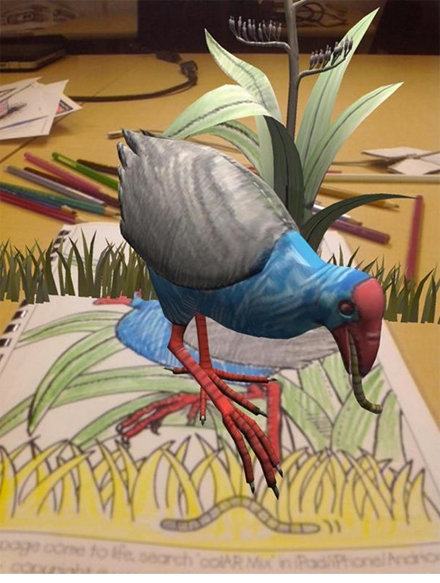
Wooooow,” a chorus of mesmerised kids exclaim at the end of a trailer for Puteko’s colAR Mix app. It’s no wonder – the app, which uses augmented reality technology to turn coloured-in paper into 3D animation, is kind of magical.
Viewing your sheet of paper through a camera on a smartphone or iPad, you can see the dragon you coloured red and green hovering above the page and start to fly. Meanwhile, your psychedelic pukeko pops up from the page and starts to scratch.
“For many kids, our product shows something that seems impossible – your colouring coming to life,” says Katy Kelly, Puteko’s producer and company co-founder.
Meanwhile the product has gone viral. Since it was developed in Canterbury University’s HIT Lab and launched in June last year, the colAR Mix app has been downloaded more than 750,000 times worldwide.
Sites like TechCrunch and Mashable have written about it and teachers, parents and tech enthusiasts are blogging. Some teachers have used it to enhance creative writing, says Katy.
“One teacher asked the kids to write a short story about our colouring page before they see it come to life, and then again after they’d seen the technology. The kids used more adjectives and emotions after seeing it come to life.”
Puteko’s primary business model is promotional colouring-in pages, where the client pays and the pages are free for the users.
They also sell “premium page packs” within the app purchase system – that is, more pictures for users to buy once they’ve coloured all the free ones.
Despite having clients, Katy says Puteko is very selective about what sort of content it allows.
“First and foremost the content needs to be interesting for kids to colour,” she says.
Recently Puteko moved its staff to shared office space near the Tokyo Tower in Japan, a country where characters like Hello Kitty, Pokemon and Mickey Mouse make up a lucrative market. These superbrands lend their characters to merchandise from stationery to household appliances to clothing, even teaming up with banks to create a “fuzzy feel-good factor” for their customers.
The idea is ‘Who wouldn’t choose a bank based on its cute Snoopy ATM card’ – and who is Idealog to argue?
New Zealand-based Sparkbox Venture Group, an early-stage investor, has put funding into Puteko, and its managing director Greg Sitters has come onto the Puteko board. Greg says brands are always looking for new ways of interacting with their consumers to maintain a customer base, and the colAR product is a way of doing that.
Puteko has launched a promotional project with DreamWorks and Kid Cuisine, which sells a range of frozen dinners for children in the USA. Kids are encouraged to visit the Kid Cuisine site, download the Puteko app, and unlock the code for special pages to colour in, featuring some of the most popular characters from DreamWorks’ animated movies – such as How to train a dragon and Madagascar.
Greg says Puteko’s technology platform has unique characteristics which will bring more capability soon. “We’re filing patents at the moment, and the technology will be evident in future versions of colAR.”
It’s all excitement now, but it was a slow start. Although the augmented reality team at HIT Lab demoed the technology at a variety of research conferences to much applause, Katy says, commercialisation didn’t happen for two years.
“The idea was too new and industries couldn’t find the market fit.” But eventually HIT Lab’s colAR team quit their day jobs and managed to commercialise the technology.
Sparkbox came on board, as did another Auckland-based seed investment fund Global from Day One (GD1). In fact Sparkbox’s Edwin Darlow thought the idea was so good he recently left to become Puteko’s CEO, freeing up Katy to focus more on product development.
“Down the line there will be all kinds of opportunities as we integrate with other programmes and technologies,” says Katy. “You could, for example, colour a character then use that character for playing a game.”
She also imagines colAR being used in 3D printing of prototypes in the design and fashion industries. Meanwhile, although research and development will stay in New Zealand, there is a plan for an office in the US in the future.




